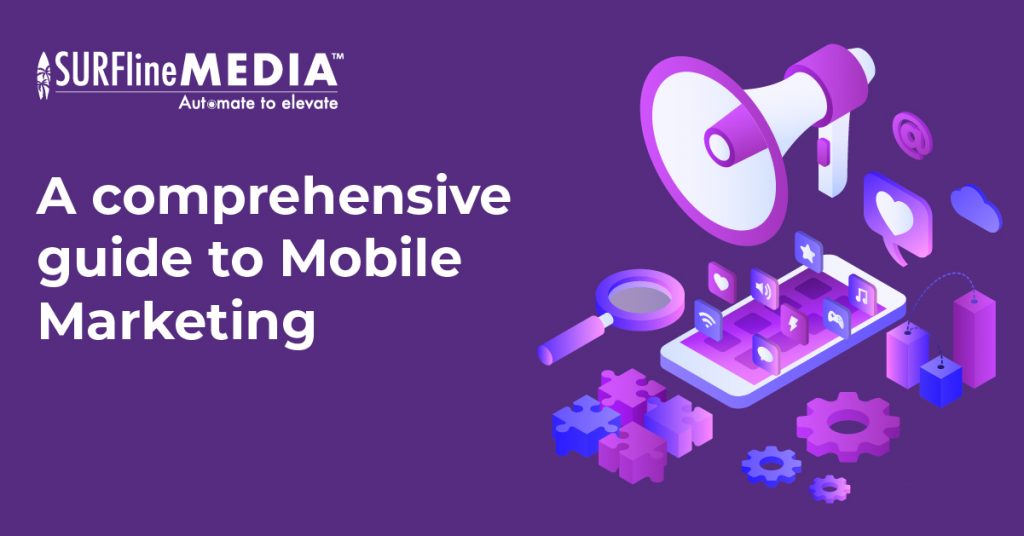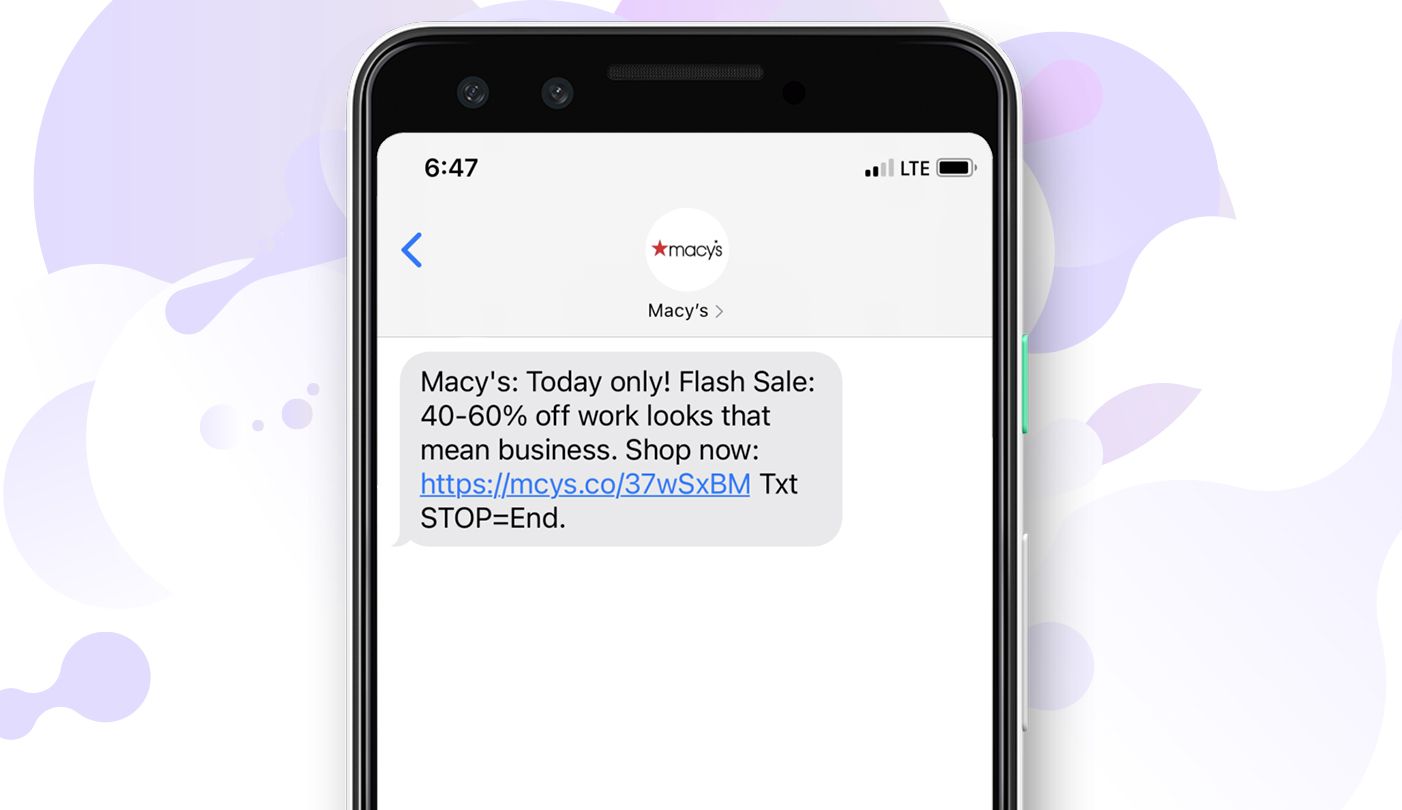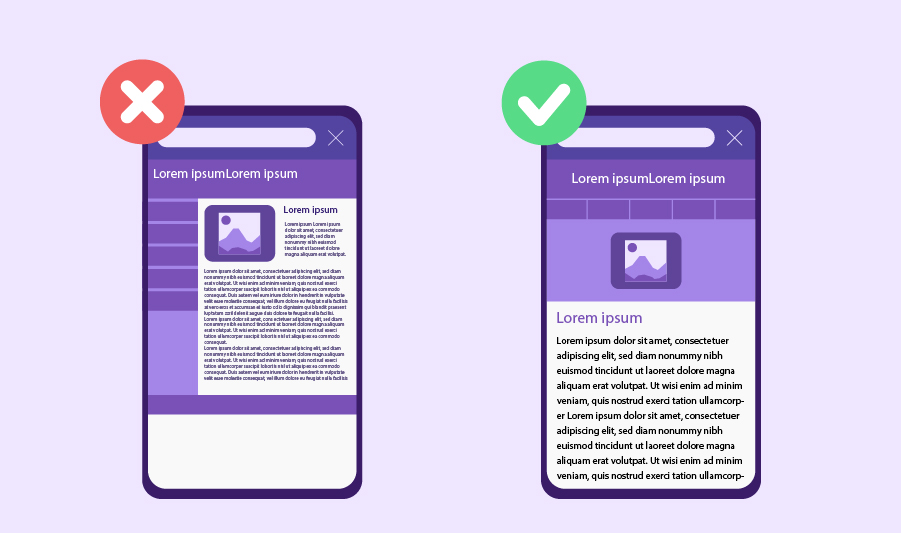

- August 16, 2023
- 4:00 pm
- No Comments
A Comprehensive Guide to Mobile Marketing (2023)
In the ever-evolving digital landscape of 2023, mobile marketing stands as a pivotal force, profoundly influencing consumer behavior and shaping marketing strategies. From its humble origins of SMS campaigns, mobile marketing has morphed into a dynamic ecosystem encompassing apps, social media, location-based targeting, and more, capitalizing on the inseparable bond between individuals and their handheld devices.
This comprehensive guide to mobile marketing serves as an indispensable resource, illuminating the latest updates and strategies that underpin successful customer engagement.
1. What is Mobile Marketing?
Mobile marketing definition refers to the specialized practice within the realm of digital marketing that centers on the use of mobile devices as a primary platform for promotional and communication activities. 
Marketing on mobile involves strategies and techniques aimed at reaching and engaging target audiences through various mobile channels, such as smartphones and tablets. Mobile marketing leverages the ubiquity and convenience of these devices to convey messages, deliver content, and facilitate interactions between businesses and their intended recipients.
This marketing approach encompasses a range of activities, from text-based SMS campaigns to multimedia-rich advertisements delivered via mobile applications, websites, and other mobile-specific channels. As an essential subset of contemporary marketing, mobile marketing capitalizes on the increasing reliance on mobile technology in modern society, enabling businesses to connect with their audiences in a highly personalized and immediate manner.
2. Mobile Marketing in Digital Marketing
Mobile marketing holds a pivotal role within the realm of digital marketing, constituting a specialized approach tailored to the unique characteristics of mobile devices. It involves crafting strategies and campaigns that optimize content and interactions specifically for smartphones, tablets, and other portable gadgets.
In the broader context of digital marketing, mobile marketing capitalizes on the prevalence of mobile device usage, aiming to reach and engage audiences through mobile-responsive websites, apps, SMS campaigns, and location-based tactics. Its significance lies in the seamless integration of marketing efforts with the mobile-centric lifestyle of consumers, enabling brands to establish direct and personalized connections.
Read more: Content Marketing vs. Digital Marketing: Key Differences and Synergies
As the mobile landscape continually evolves, this subset of digital marketing adapts, incorporating innovations such as mobile apps, QR codes, and augmented reality experiences to create compelling and impactful interactions that drive brand awareness, engagement, and conversion.
3. Key Mobile Marketing Channels
3.1 Mobile Apps
In the dynamic realm of mobile marketing, branded mobile applications stand out as a potent tool for fostering direct engagement and building lasting connections with audiences. These apps offer a multifaceted range of benefits that amplify marketing efforts.
Branded mobile apps enable direct and immediate communication with users, bypassing the clutter of other communication channels. Push notifications serve as a direct line to users’ screens, allowing businesses to share timely updates, promotions, and announcements in real time. This instant connection enhances brand visibility and recall.

Mobile app marketing boosts visibility, engagement, and downloads for apps, driving success in the digital ecosystem.(source: AppAgent)
Moreover, mobile apps facilitate personalized experiences. By analyzing user behavior and preferences, apps can deliver tailor-made content, recommendations, and offers, fostering a sense of exclusivity and relevance. This personal touch enhances user engagement and loyalty.
Loyalty programs integrated into mobile apps provide an additional incentive for users to engage with a brand consistently. Points, rewards, and exclusive discounts create a gamified experience that encourages repeat visits and purchases.
3.2 SMS Marketing
SMS marketing, an integral facet of mobile marketing, wields a unique power in its directness and immediacy. The unobtrusive nature of text message marketing allows businesses to reach their target audience instantly and effectively.
Harnessing the potential of SMS campaigns involves crafting content that captures attention while respecting the user’s space. Short, concise messages are key, delivering valuable information or exclusive offers in a succinct manner. To avoid intrusiveness, it’s vital to obtain explicit consent and provide an easy opt-out mechanism, ensuring users feel in control of their engagement.

SMS marketing delivers concise messages to engage customers instantly, fostering direct communication and brand awareness (source: VertexSMS Blog)
Embracing personalization further enhances SMS campaigns’ impact. Addressing recipients by name and tailoring messages based on preferences cultivates a sense of relevance. Timing also plays a pivotal role – sending messages during non-intrusive hours maximizes the likelihood of engagement. Incorporating clear calls to action (CTAs) prompts recipients to take desired actions, whether it’s visiting a website, redeeming an offer, or participating in a contest.
3.3 Mobile-Optimized Websites
In the age of mobile dominance, having a mobile-optimized website is not just a choice, but a necessity for effective digital engagement. Responsive design and swift loading times are paramount in delivering a seamless and satisfying mobile browsing experience.

Mobile-optimized websites ensure seamless user experiences on smartphones, enhancing accessibility and conversion rates.
Responsive design ensures that your website adapts effortlessly to various screen sizes and orientations, preserving its usability and visual appeal. It guarantees that users can access your content, navigate easily, and interact comfortably, regardless of the device they’re using.
Equally crucial is the speed at which your website loads on mobile devices. Mobile users have limited patience for sluggish loading times. A fast-loading website enhances user satisfaction, reduces bounce rates, and positively impacts search engine rankings.
3.4 Location-Based Marketing
Location-based marketing harnesses the power of geographical context to deliver targeted and relevant experiences, making it a vital player in the mobile marketing arena. Two notable tactics within this strategy are geotargeting and geofencing.

Location-based marketing tailors content to users’ physical proximity, creating personalized interactions and promoting local engagement (source: PoiLabs)
Geotargeting allows businesses to tailor content and promotions based on users’ specific geographic locations. By understanding where users are, marketers can deliver messages that resonate with their immediate surroundings, enhancing the likelihood of engagement and conversions.
Geofencing, on the other hand, sets virtual boundaries around specific physical locations. When users enter or exit these defined areas, they receive notifications or offers, creating timely interactions that are directly tied to their real-world movements.
3.5 Social Media on Mobile
Social media emerges as a dynamic and influential channel, transforming the way brands connect with audiences. The prevalence of social media apps on mobile devices has led to a paradigm shift in digital engagement.
Mobile social media presents a visually engaging and interactive platform, allowing brands to share content, communicate directly, and build relationships in real time. Visual-rich posts, stories, and videos resonate strongly with users, drawing them into immersive brand experiences.
Read more: Social Media Automation: 2023 Guide for Beginners
The mobile-centric nature of social media also encourages spontaneous interactions, tapping into micro-moments of engagement as users scroll through their feeds on the go. Advertisements, sponsored content, and influencer collaborations can seamlessly integrate with users’ content consumption. Moreover, features like location tagging, hashtags, and live streaming enable brands to create contextually relevant campaigns, fostering authenticity and user participation.
4. Mobile Marketing Strategies
4.1 Personalization
Personalization stands as a cornerstone of effective mobile marketing, empowering brands to create experiences that resonate deeply with individual users. Data-driven personalization leverages insights gathered from user behavior, preferences, and demographics to craft tailored content and interactions.
In the mobile landscape, personalization takes on new dimensions. Mobile devices are intimately connected to users, offering a trove of information that can be harnessed to curate relevant experiences. From personalized recommendations in mobile apps to customized email campaigns, data-driven personalization enhances user engagement by delivering content that aligns with their interests and needs.
Furthermore, location-based personalization capitalizes on users’ geographic context to provide real-time information and offers, creating a sense of immediacy and relevance. When executed effectively, personalization fosters deeper connections, increases user satisfaction, and drives conversions, as users feel understood and valued by brands that tailor their mobile experiences to individual preferences.
4.2 Push Notifications
Push notifications emerge as a potent mobile marketing strategy, delivering timely updates and information directly to users’ devices. However, their success hinges on finding the delicate equilibrium between engagement and intrusion.
To optimize push notifications, it’s paramount to deliver value-driven content that aligns with users’ interests. Craft messages that offer exclusive promotions, relevant news, or personalized recommendations, enriching users’ experience without overwhelming them.

Push notifications deliver timely alerts, boosting user engagement and driving actions within mobile apps (source: Reteno)
Frequency and timing are key considerations. Bombarding users with notifications risks alienation, while sparse communication may lead to disengagement. Tailor the frequency to suit users’ preferences and behaviors, and schedule notifications during non-intrusive hours to ensure they are received and appreciated.
Segmentation plays a vital role in enhancing relevance. Divide your audience based on demographics, behaviors, or preferences, allowing you to send targeted notifications that cater to specific interests. Balancing value and discretion ensures that push notifications remain a valuable tool for mobile engagement, fostering brand loyalty and enriching user experiences without crossing the line into annoyance.
4.3 In-App Advertising
In-app advertising has become a cornerstone of mobile advertising, enabling brands to engage users seamlessly within the apps they use daily. Various ad formats, including banner ads, interstitials, and native ads, offer diverse ways to capture attention and drive results.
Banner ads, with their unobtrusive presence at the top or bottom of screens, provide continuous visibility without disrupting the user experience. Interstitials, appearing between app content transitions, offer more immersive engagement, providing opportunities for interactive multimedia experiences.

In-app advertising integrates ads seamlessly, offering relevant content and revenue opportunities to app users (source: Design Inc)
Native ads blend seamlessly with app content, mirroring the app’s design and tone. Their non-disruptive nature encourages higher user engagement and click-through rates. When deploying in-app mobile marketing advertising, relevance is paramount. Tailor ad content to match app context and user interests, ensuring that ads resonate with the audience. Striking the right balance between visibility and user experience is key, ensuring ads enhance rather than hinder the app experience.
4.4 Mobile SEO
Mobile SEO is a critical facet of modern mobile marketing, tailored to enhance a brand’s online visibility in mobile search results. With a significant portion of internet searches originating from mobile devices, optimizing websites for mobile-friendliness is paramount.
Mobile-friendly SEO practices involve responsive design, ensuring that websites adapt seamlessly to various screen sizes and orientations. This ensures users have a positive browsing experience, leading to lower bounce rates and extended engagement.
Page speed is equally crucial. Mobile users expect swift loading times, and search engines prioritize fast-loading sites. Compressing images, minifying code, and utilizing browser caching contribute to optimizing page speed. Moreover, leveraging mobile-specific features like Google’s Accelerated Mobile Pages (AMP) can further enhance website performance and visibility.
5. Optimizing Mobile Marketing Campaigns
5.1 A/B Testing
A/B testing plays a pivotal role in optimizing mobile marketing campaigns. By comparing two variations of a campaign element, marketers gain insights into what resonates best with their audience. This iterative approach refines content, design, and calls-to-action, resulting in campaigns that deliver higher engagement and conversion rates.
A/B testing empowers marketers to make data-driven decisions, continuously improving campaigns for maximum impact in the ever-evolving mobile landscape.
5.2 Analytics and Tracking
Analytics and tracking tools are indispensable for evaluating the success of mobile marketing efforts. Metrics like user engagement, conversion rates, and return on investment (ROI) offer valuable insights into campaign performance. These tools enable marketers to gauge the effectiveness of various strategies, assess user behavior, and make informed adjustments.
By interpreting analytics data, marketers can optimize their mobile campaigns to better align with audience preferences and achieve quantifiable results.
5.3 User Feedback and Reviews
Soliciting user feedback and leveraging positive reviews are integral to building credibility and trust in mobile marketing campaigns. User opinions provide valuable insights, highlighting strengths and pinpointing areas for improvement.
Incorporating user suggestions enhances the user experience and demonstrates a brand’s commitment to meeting customer needs. Positive reviews, when showcased, serve as social proof, influencing potential customers’ decisions. Engaging with user feedback fosters a sense of partnership and loyalty, showing that a brand values its audience and is dedicated to delivering exceptional mobile experiences.
6. Navigating Challenges in Mobile Marketing
6.1 Privacy Concerns
Amid mounting data privacy concerns, building trust is essential when collecting user data for mobile marketing. Transparency about data usage, clear privacy policies, and obtaining explicit consent are crucial. Emphasize data security measures and allow users to control their preferences.
By demonstrating ethical data practices, brands can alleviate concerns and create a more trusting relationship with users, fostering a foundation for successful mobile marketing campaigns.
6.2 Ad Blockers
The prevalence of ad blockers poses a challenge in mobile marketing, but strategies exist to bypass these obstacles. Focus on creating non-intrusive, valuable content that users won’t want to block. Employ native advertising, influencer partnerships, or immersive experiences that ad blockers can’t easily disrupt.
Additionally, diversify your marketing mix to include channels beyond traditional ads, such as email or content marketing, ensuring your message still reaches your target audience.
6.3 Platform Diversity
Catering to multiple mobile platforms, like iOS and Android, requires strategic planning. Design responsive experiences that work seamlessly across various devices. Prioritize functionality over intricate design elements to ensure consistency.
Leverage cross-platform development tools and focus on core features that align with each platform’s user expectations. Regularly test and adapt to platform updates, maintaining a user-centric approach that accommodates the diversity of the mobile ecosystem and delivers a consistent experience regardless of the platform.
7. Conclusion
Mobile marketing has emerged as a pivotal avenue that connects brands directly with their audiences. As mobile devices continue to shape the way people interact with content and make purchasing decisions, mastering mobile marketing strategies is paramount for success.
In this dynamic landscape, Surfline Media stands as a beacon of expertise and innovation. As a leading digital agency, we possess a deep understanding of the intricacies of mobile marketing. Our comprehensive services encompass the latest trends and techniques, ensuring your brand’s message resonates effectively across mobile platforms. Contact us today to explore how our expertise can elevate your mobile marketing endeavors.
_______________________

Surfline Media – Automate to Elevate
Our website: https://surflinemedia.com/
Contact us: https://surflinemedia.com/contact-us/
Phone number: +1 323-741-4482
Email: [email protected]






